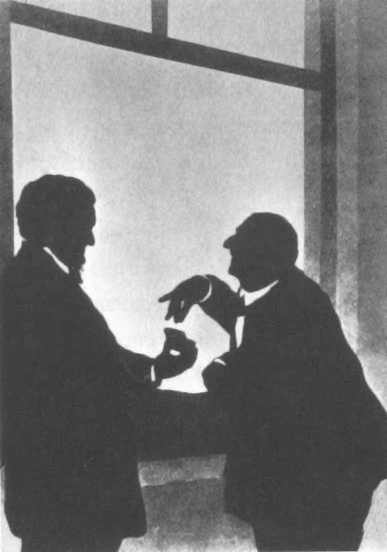In majestic Bruckner Third, Barenboim defies conventional wisdom

Silhouette of Anton Bruckner with Richard Wagner by Otto Boehler.
Conventional wisdom holds that the first three of Anton Bruckner’s symphonies are worth hearing solely as historical curiosities—the early works of a composer in development—and that the real plums are Nos. 4 and beyond. In a series of nine concerts at Carnegie Hall with the Staatskapelle Berlin, playing the symphonies in chronological order, Daniel Barenboim is proving that premise false.
Barenboim is coupling Bruckner with Mozart, mostly piano concertos, with the conductor leading from the keyboard. Saturday evening’s installment began with Mozart’s Piano Concerto No. 24 in C Minor, K. 491—along with No. 20, the only one he wrote in a minor key. Compared to the composer’s typical bent toward cheerfulness, this example is unusually subdued.
When Barenboim arrived at the podium, he wasted no time, plunging into the majestic orchestral introduction with a modest-sized ensemble. Only three double basses were used, leaving five more resting on stage, a tantalizing hint of what would appear after intermission. Limpid flute and bassoon lines were delightfully audible, thanks to the conductor’s genial tempo.
As soloist in the first movement, Barenboim’s most notable contribution was a carefully incised cadenza, with some resonant growls in the piano’s lower register. The second movement was simplicity itself, with wind choirs offering little bursts of joy, which kept reappearing until the peaceful final measures.
The final Allegretto begins with a startlingly chromatic piano line, creeping around by half-steps, before the orchestra erupts in a dense reply, a weighty, dignified march. With tempos not too fast, Barenboim elicited marvelous dialogue from the musicians. In the first three of these evenings, his rapport with the players has been not only audible, but visible. A rapt audience summoned him out three times—deservedly—and this, before the concert’s second half.
The conductor has reportedly expressed great admiration for Bruckner’s early symphonies, and his reading of the Third amplified his view that they deserve more performances. Notably, he used no score. (The Third stirs up the most vehement arguments about which edition to use. Barenboim opted for the 1878 version.)
In this work the composer expresses his admiration for Wagner—hence the score’s inscription, “To the Master, Richard Wagner, in deepest awe and reverence.” Shortly after the first movement opens, trumpets ignite a unison torrent, leading to a motif that resembles an inverted take on music from Siegfried, and other Wagnerian references make brief appearances here and there. Barenboim exercised calm restraint, letting the chorales ring out, and—as was the case all night—massive tuttis were heroically satisfying, yet inner voices were always audible. A declamatory unison near the movement’s end struck like a lightning bolt.
Similar to the two earlier symphonies, the Third has a gently persuasive slow movement. Barenboim showed an uncanny ability to let the phrases unfold with tempi neither brisk nor torpid, in Celibidache style. Weighty contributions of the strings had both lushness and accuracy, and Barenboim carefully framed those paragraphs bookended by silence, helped by a remarkably quiet audience. The final sustained chord, with trumpets and strings, was mesmerizing in its even, calm restraint.
Tiptoeing at first and increasing in frenzy, the waltz-like Scherzo has one of the composer’s most delectable trio sections. Violas were front-and-center with a warm, melodic embrace, like flowers in a meadow. But that idyll eventually gave way to the increasing statements from the brass, raining down to end it all.
In the finale, a gracious little polka is the surprise gift, with the violins offering innocence and charm, like a Brucknerian riff on Dvořák’s Slavonic Dances. Eventually the brass-heavy contingent begins to foreshadow the massive conclusion, a series of crescendos, and the slow crawl was masterfully handled by the ensemble.
The polka reappears—slower, as if exhausted—as the momentum begins to accumulate toward the conclusion. A final fortissimo unison, led with triumphant abandon by trumpets and trombones, was thrilling, before the last measures came into view with blazing contributions from the entire ensemble.
There are six concerts to go in this first Bruckner cycle ever presented in the United States. If Barenboim and this superb orchestra can maintain this level of energy, momentum, and accomplishment, these nine nights (and one afternoon) will be recalled by many as concerts for the ages.
The Bruckner series with Daniel Barenboim and Staatskapelle Berlin continues 8 p.m. Monday with Mozart’s Piano Concerto No. 26 in D Major and Bruckner’s Symphony No. 4 in E-flat Major. carnegiehall.org; 212-247-7800.



Posted Jan 22, 2017 at 5:34 pm by Jacqui Danilow
Wonderfully written review! Thank you for
this in depth description of a concert I sorely
missed!!!